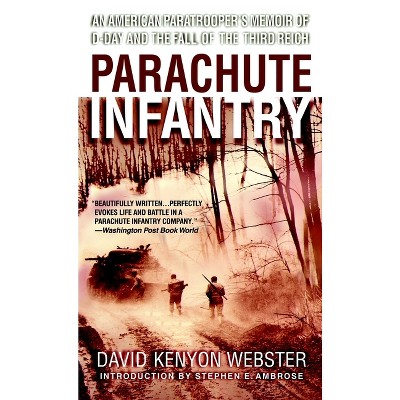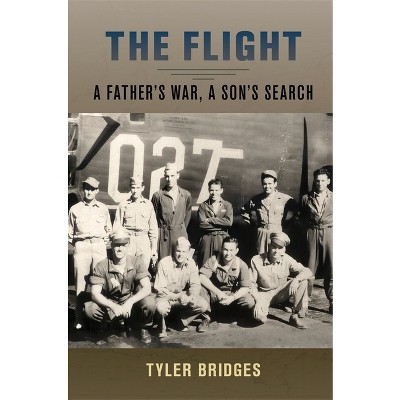$38.49 sale price when purchased online
$44.95 list price
Target Online store #3991
About this item
Highlights
- An English literature major at Harvard with a talent for writing, twenty-one-year-old David Kenyon Webster volunteered for duty in the U.S. Army's parachute infantry in 1943 with the aim of seeing combat first-hand and then describing his experiences.
- About the Author: David Kenyon Webster worked as a reporter and writer after the war.
- 288 Pages
- History, Military
Description
Book Synopsis
An English literature major at Harvard with a talent for writing, twenty-one-year-old David Kenyon Webster volunteered for duty in the U.S. Army's parachute infantry in 1943 with the aim of seeing combat first-hand and then describing his experiences. His introduction to warfare came at the invasion of Normandy on D-Day in 1944.
Webster went on to see considerable action in the next two years, serving as a combat infantryman in the campaign through northwest Europe, during which he was twice wounded. He wrote Parachute Infantry a short time after the war, relying on his letters home and recollections he penned right after his discharge, making his memoir much closer to the war than most such works. With its abundant dialogue, charged descriptions of places and events, and skillful evocation of emotions, Webster's narrative resonates with the immediacy of a gripping novel. The memoir is divided into several episodes. The first takes place in May and June of 1944 and provides a detailed, suspenseful account of Webster's participation in the events of D-Day. The next covers several days in September, 1944, when Webster parachuted into Holland and then as part of a group of soldiers advanced through small towns, freeing them as the Germans retreated, until he was shot in the leg and forced to leave his unit. The narrative then picks up in February, 1945, after Webster has returned to his unit, and describes several weeks near the end of the war in Europe, when German resistance was still strong but weakening. Then comes the Allied victory in 1945. We see Webster's platoon arriving at Berchtes gaden (Hilter's vacation retreat in the Alps) right before V-E Day and the celebrations and lax discipline that followed the final collapse of the Third Reich. In the last section of the book, Webster recalls the monotonous routine of occupation duty, concluding with his return to the States in early 1946 to be discharged. Stephen E. Ambrose introduces Parachute Infantry, pointing out as two important strengths Webster's honesty and his ability to describe so well his fellow soldiers--men he never would have known or associated with in civilian life but with whom he developed the strongest bonds during his wartime experience. Parachute Infantry proves to be a riveting account of a young soldier's experience of war.From the Back Cover
An English literature major at Harvard with a talent for writing, twenty-one-year-old David Kenyon Webster volunteered for duty in the U.S. Army's parachute infantry in 1943 with the aim of seeing combat firsthand and then describing his experiences. His introduction to warfare came at the invasion of Normandy on D-Day in 1944. Webster went on to see considerable action in the next two years, serving as a combat infantryman in the campaign through northwest Europe, during which he was twice wounded. He wrote Parachute Infantry a short time after the war, relying on his letters home and recollections he penned right after his discharge, making his memoir much closer to the war than most such works. With its abundant dialogue, charged descriptions of places and events, and skillful evocation of emotions, Webster's narrative resonates with the immediacy of a gripping novel. The memoir is divided into several episodes. The first takes place in May and June of 1944 and provides a detailed, suspenseful account of Webster's participation in the events of D-Day. The next covers several days in September, 1944, when Webster parachuted into Holland and then as part of a group of soldiers advanced through small towns, freeing them as the Germans retreated, until he was shot in the leg and forced to leave his unit. The narrative then picks up in February, 1945, after Webster has returned to his unit, and describes several weeks near the end of the war in Europe, when German resistance was still strong but weakening. Then comes the Allied victory in 1945. We see Webster's platoon arriving at Berchtesgaden (Hitler's vacation retreat in the Alps) right before V-E Day and the celebrations and laxdiscipline that followed the final collapse of the Third Reich. In the last section of the book, Webster recalls the monotonous routine of occupation duty, concluding with his return to the States in early 1946 to be discharged. Stephen E. Ambrose, director of the Eisenhower Center at the University of New Orleans, introduces Parachute Infantry, pointing out as two important strengths Webster's honesty and his ability to describe so well his fellow soldiers - men he never would have known or associated with in civilian life but with whom he developed the strongest bonds during his wartime experience. Parachute Infantry proves to be a riveting account of a young soldier's experience of war.Review Quotes
David Webster's vivid description of D-Day and the days that followed merits a place among the classic accounts of men in battle.--Page Smith
I recommend this memoir to anyone who wants to know more about World War II, about combat, about being a paratrooper, about discovering oneself and being involved when the whole world was being tested and threatened. It brings back a place and a time, a sense of commitment, the felling of 'we are in this together' as the United State and her allies fought for freedom.--Stephen E. Ambrose, from his Introduction
About the Author
David Kenyon Webster worked as a reporter and writer after the war. The Saturday Evening Post published a brief portion of his memoir, but book publishers rejected his manuscript, seeking sensationalized novels of the war rather than authentic memoirs. He died in 1961 in a boating accident while shark fishing.
Stephen E. Ambrose (1936-2002), was Boyd Professor of History at the University of New Orleans and author of many biographies and histories, including D-Day, June 6, 1944: The Climactic Battle of World War II and Upton and the Army.Dimensions (Overall): 6.2 Inches (H) x 9.1 Inches (W) x 1.0 Inches (D)
Weight: 1.15 Pounds
Suggested Age: 22 Years and Up
Number of Pages: 288
Genre: History
Sub-Genre: Military
Publisher: LSU Press
Theme: World War II
Format: Hardcover
Author: David Kenyon Webster
Language: English
Street Date: April 1, 1994
TCIN: 1002059684
UPC: 9780807119013
Item Number (DPCI): 247-22-8704
Origin: Made in the USA or Imported
If the item details above aren’t accurate or complete, we want to know about it.
Shipping details
Estimated ship dimensions: 1 inches length x 9.1 inches width x 6.2 inches height
Estimated ship weight: 1.15 pounds
We regret that this item cannot be shipped to PO Boxes.
This item cannot be shipped to the following locations: American Samoa (see also separate entry under AS), Guam (see also separate entry under GU), Northern Mariana Islands, Puerto Rico (see also separate entry under PR), United States Minor Outlying Islands, Virgin Islands, U.S., APO/FPO
Return details
This item can be returned to any Target store or Target.com.
This item must be returned within 90 days of the date it was purchased in store, shipped, delivered by a Shipt shopper, or made ready for pickup.
See the return policy for complete information.
Trending Non-Fiction


$22.40
Buy 1, get 1 50% off select books, games & more
5 out of 5 stars with 3 ratings

$14.20
MSRP $27.00
Buy 1, get 1 50% off select books, games & more
4.8 out of 5 stars with 554 ratings

$12.54
MSRP $22.00
Buy 1, get 1 50% off select books, games & more
4.6 out of 5 stars with 14 ratings

$20.18
was $24.50 New lower price
Buy 1, get 1 50% off select books, games & more
5 out of 5 stars with 11 ratings

$10.99
MSRP $19.99
Buy 1, get 1 50% off select books, games & more
4.9 out of 5 stars with 287 ratings






